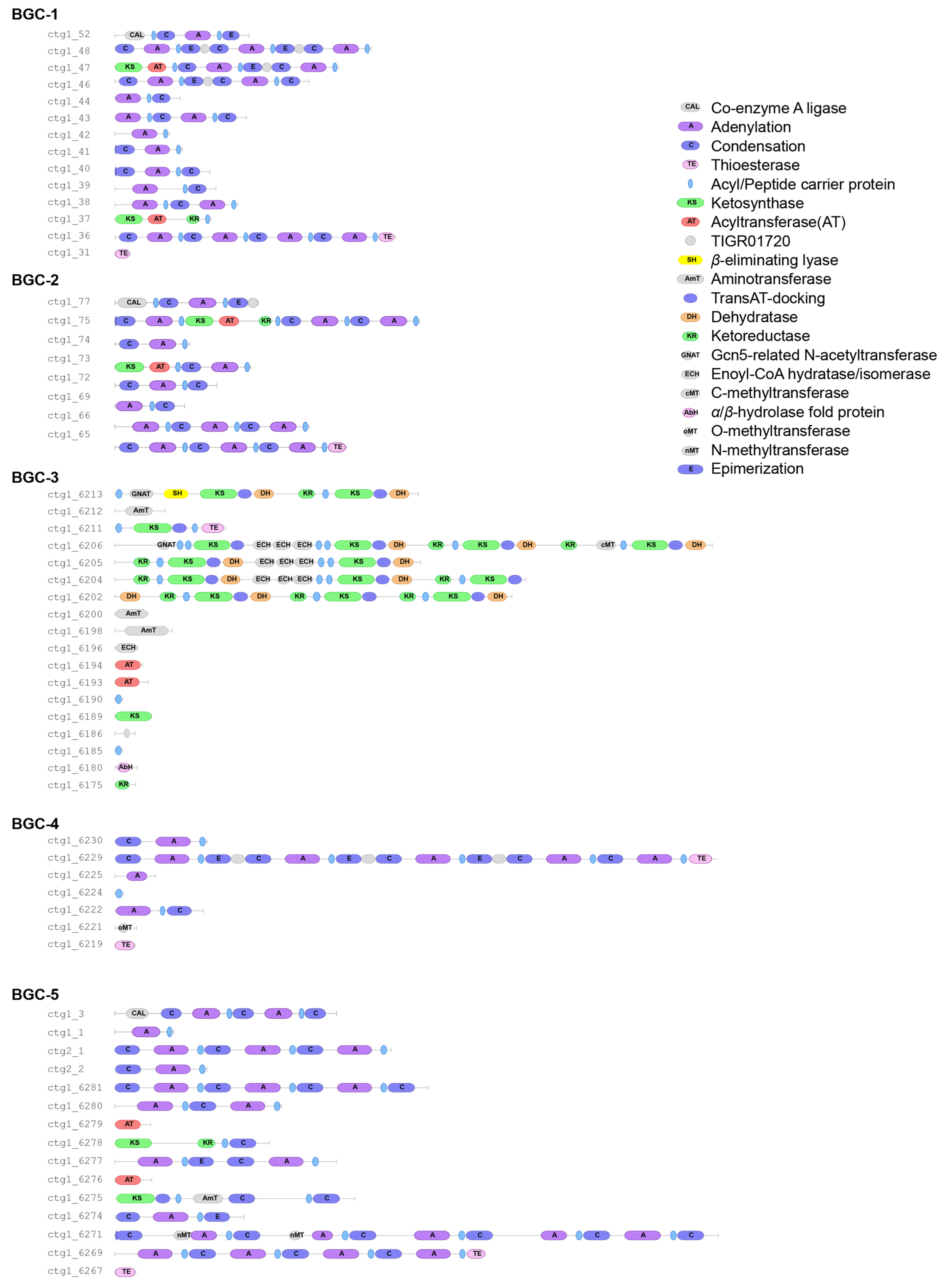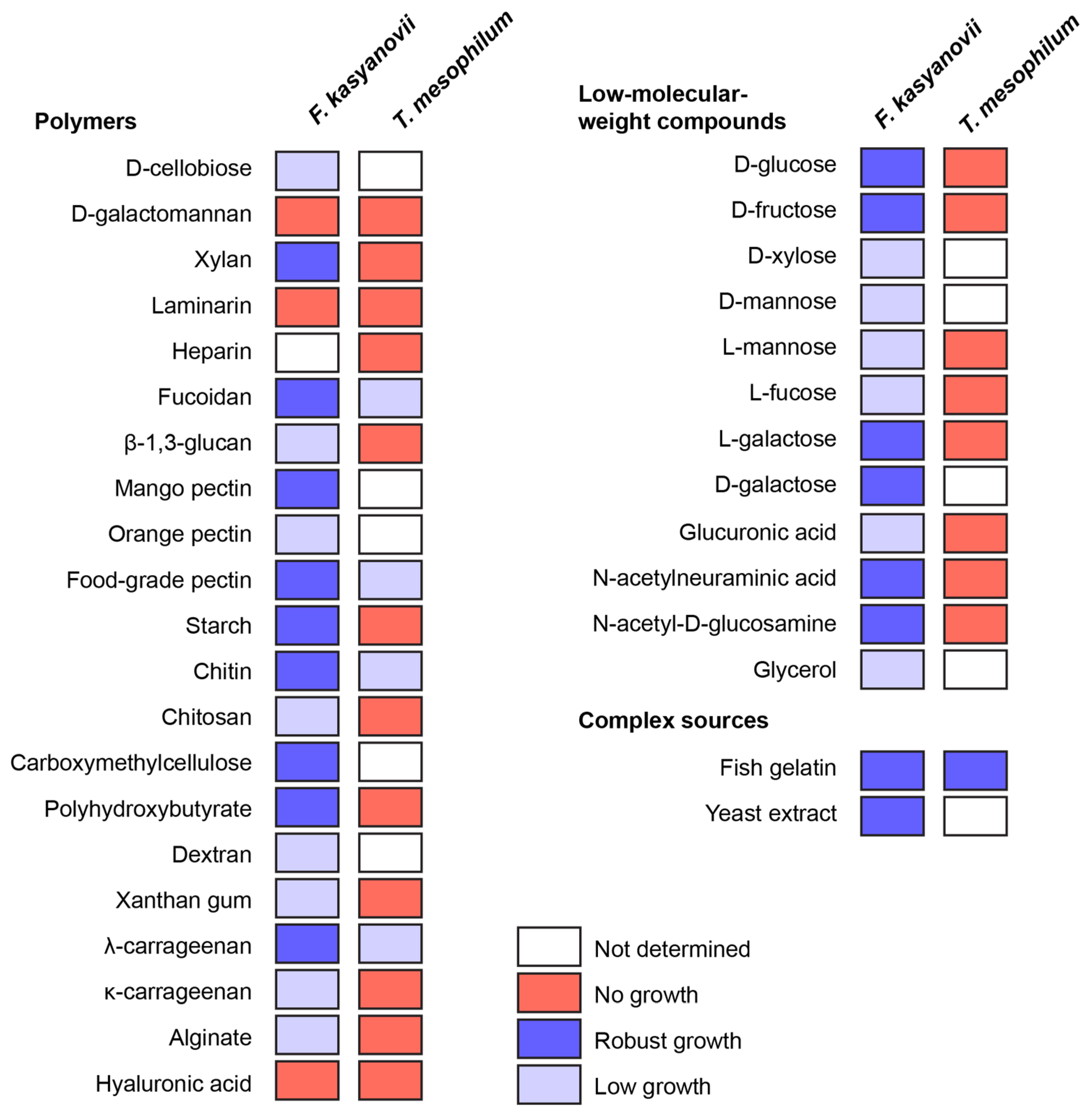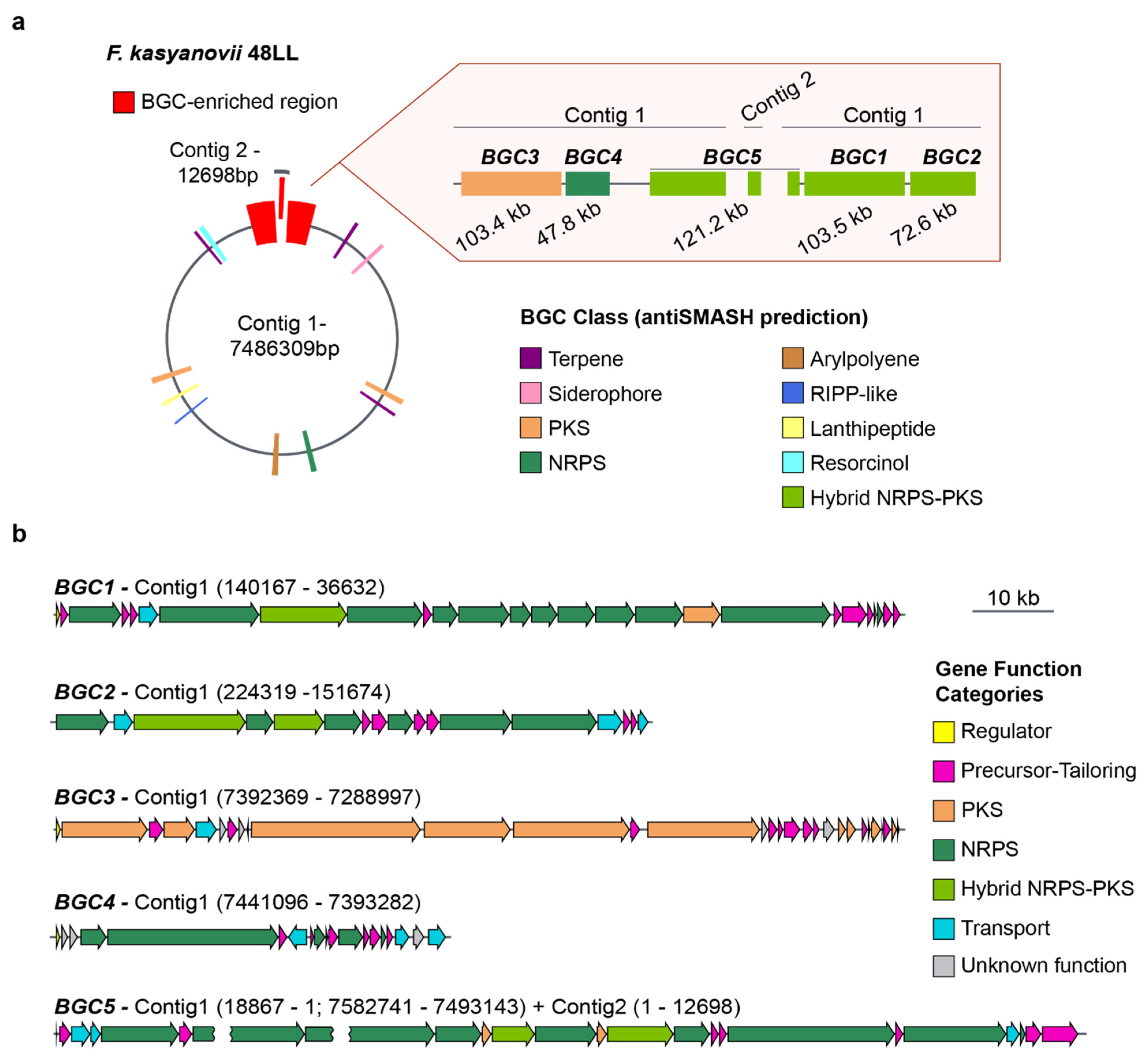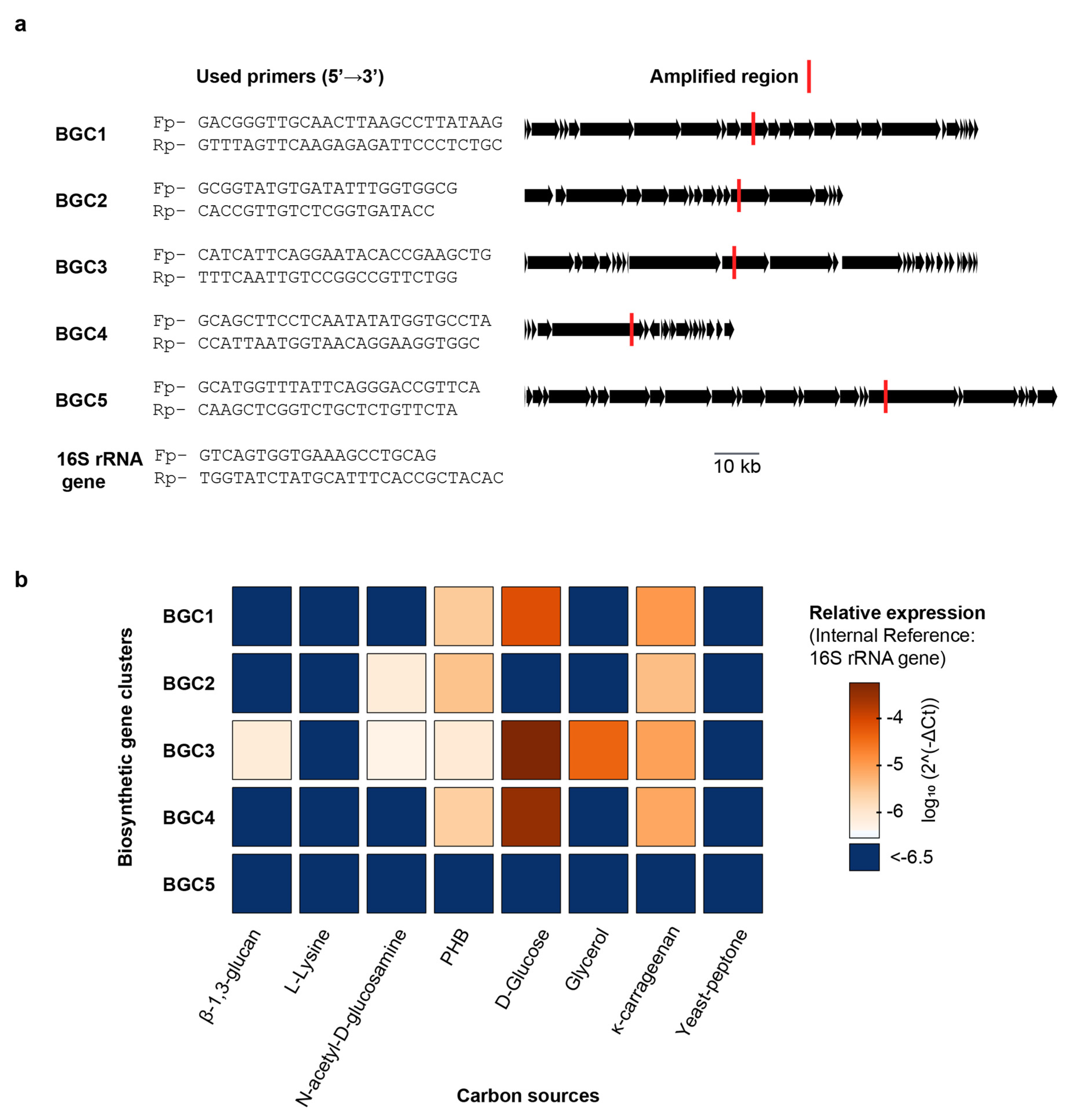Carbon-Source Effects on Growth and Secondary Metabolism in the Marine Bacteroidota Tenacibaculum mesophilum and Fulvivirga kasyanovii
Abstract
1. Introduction
2. Results
2.1. Carbon Source Preferences of Fulvivirga kasyanovii 48LL and Tenacibaculum mesophilum fLL in Defined Media
2.2. Carbon-Source-Dependent Induction of Antimicrobial Activity of F. kasyanovii Extracts
2.3. Secondary Metabolite Biosynthetic Gene Clusters of F. kasyanovii
2.4. Carbon-Source-Dependent Regulation of Biosynthetic Gene Clusters in F. kasyanovii
3. Discussion
4. Materials and Methods
4.1. Cultivation of Bacterial Strains and Maintenance
4.2. Development of a Defined Medium for F. kasyanoviii
4.3. Development of a Defined Medium for T. mesophilum
4.4. Growth Test in a Carbon Source Library
4.5. Chemical Extraction
4.6. Antibacterial Assay of F. kasyanovii Chemical Extracts
4.7. Genome Sequencing and BGC Characterization of F. kasyanovii
4.8. RNA Extraction
4.9. Reverse Transcription
4.10. Quantitative PCR
5. Conclusions
Author Contributions
Funding
Institutional Review Board Statement
Data Availability Statement
Acknowledgments
Conflicts of Interest
Abbreviations
| BGC | Biosynthetic gene cluster |
| NRPS | Non-ribosomal peptide synthase |
| PKS | Polyketide synthase |
| RiPPs | Ribosomally synthesized and post-translationally modified peptide |
| PHB | Polyhydroxybutyrate |
| qPCR | Quantitative polymerase chain reaction |
Appendix A

| Reagent | Solution Concentration |
|---|---|
| L-glutamine | 50 mg mL−1 HCl 1 M |
| L-histidine | 50 mg mL−1 water |
| L-glutamic acid | 50 mg mL−1 HCl 1 M |
| L-tyrosine | 50 mg mL−1 HCl 1 M |
| L-cysteine hydrochloride | 50 mg mL−1 water |
| L-methionine | 50 mg mL−1 HCl 1 M |
| L-tryptophan | 50 mg mL−1 HCl 0.5 M |
| trans-4-hydroxy-L-proline | 50 mg mL−1 water |
| L-leucine | 50 mg mL−1 HCl 1 M |
| L-phenylalanine | 50 mg mL−1 KOH 0.5 M, heat, stir |
| L-valine | 50 mg mL−1 water |
| L-aspartic acid | 50 mg mL−1 HCl 0.5 M, heat, stir |
| L-asparagine | 50 mg mL−1 HCl 1 M |
| L-threonine | 50 mg mL−1 water |
| L-lysine hydrochloride | 50 mg mL−1 water |
| L-serine | 50 mg mL−1 water |
| L-arginine hydrochloride | 50 mg mL−1 water |
| L-isoleucine | 50 mg mL−1 KOH 0.5 M |
| L-alanine | 50 mg mL−1 water |
| L-cystine | 50 mg mL−1 HCl 1 M |
| Glycine | 50 mg mL−1 water |
| Ferrous sulfate (FeII) | 50 mg mL−1 water |
| Vitamin B12 | 0.5 mg mL−1 water |
| Amino Acid | Solution (µL) |
|---|---|
| Glycine | 91.2 |
| Arginine | 91.2 |
| Lysine | 91.2 |
| Cysteine | 91.2 |
| Glutamic acid | 91.2 |
| Hydroxyproline | 91.2 |
| Alanine | 73 |
| Proline | 73 |
| Aspartate | 73 |
| Serine | 58 |
| Leucine | 29.2 |
| Threonine | 29.2 |
| Valine | 29.2 |
| Phenylalanine | 14.6 |
| Isoleucine | 14.6 |
| Methionine | 14.6 |
| Histidine | 7.3 |
| Cystine | 7.3 |
| Tyrosine | 7.3 |
| Tryptophan | 7.3 |
| Asparagine | 7.3 |
| Glutamine | 7.3 |
| Substrate | Brand | Stock Solution | Sterilization | Amount per 1 mL Medium |
|---|---|---|---|---|
| Mango pectin | UNT Agroindustry Lab (Trujillo, Peru) | 70 mg mL−1 water | Autoclave | 14.2 µL |
| Food-grade pectin | Suman (Trujillo, Peru) | 70 mg mL−1 water | Autoclave | 14.2 µL |
| D(+) Glucose | Panreac (Barcelona, Spain) | 200 mg mL−1 water | 0.2 µm filter | 20.0 µL |
| D(−) Fructose | Merck (Darmstadt, Germany) | 100 mg mL−1 water | Autoclave | 25.0 µL |
| Chitin | Spectrum (Middleton, WI, USA) | Used directly | Autoclave | 0.400 mg |
| D(+) Xylose | Merck (Darmstadt, Germany) | 20 mg mL−1 water | Autoclave | 20.0 µL |
| L(−) Mannose | Spectrum (Middleton, WI, USA) | 200 mg mL−1 water | 0.2 µm filter | 20.0 µL |
| Yeast extract (granulated) | Merck (Darmstadt, Germany) | Used directly | Autoclave | 3.000 mg |
| Cold-water fish gelatin | Sigma (Burlington, MA, USA) | Used directly | Autoclave | 3.000 mg |
| Dextran (Sephadex LH-20) | Sigma (Burlington, MA, USA) | Used directly | Autoclave | 1.920 mg |
| λ-Carrageenan | ChemCruz (Huissen, The Netherlands) | 10 mg mL−1 water | 58 °C 2 h | 150.0 µL |
| Xanthan gum | TCI (Tokyo, Japan) | 5 mg mL−1 water | 58 °C 2 h | 300.0 µL |
| β-1,3-Glucan | ChemCruz (Huissen, The Netherlands) | 20 mg mL−1 water | 58 °C 2 h | 40.0 µL |
| L(−) Fucose | ChemCruz (Huissen, The Netherlands) | 20 mg mL−1 water | 0.2 µm filter | 200.0 µL |
| Carboxymethyl cellulose | Dropaksa (Trujillo, Peru) | 25 mg mL−1 water | Autoclave | 80.0 µL |
| Orange pectin | UNT Agroindustry Lab (Denton, TE, USA) | 70 mg mL−1 water | Autoclave | 14.2 µL |
| Polyhydroxybutyrate | UNT Environmental Eng. Lab (Denton, TE, USA) | Used directly | 60 °C 24 h | 0.260 mg |
| Glycerol (molecular biology grade) | Merck-Millipore (Darmstadt, Germany) | Used directly | Autoclave separately | 20.0 µL |
| N-Acetyl-D-glucosamine | Thermo Fisher Scientific (Waltham, MA, USA) | 50 mg mL−1 water | 0.2 µm filter | 40.0 µL |
| Fucoidan | Toronto Research Chemical (North York, Ontario. Canada) | 20 mg mL−1 water | 58 °C 2 h | 25.0 µL |
| κ-Carrageenan | ChemCruz (Huissen, The Netherlands) | 5 mg mL−1 water | 58 °C 2 h | 100.0 µL |
| Sodium alginate | Sigma (Burlington, MA, USA) | Used directly | Autoclave | 2.000 mg |
| Corn-core xylan | TCI (Tokyo, Japan) | 100 mg mL−1 water | 58 °C 2 h | 30.0 µL |
| L-(−) Galactose | TCI (Tokyo, Japan) | 9.87 mg mL−1 water | 0.2 µm filter | 50.0 µL |
| N-Acetylneuraminic acid | ChemCruz (Huissen, The Netherlands) | 49.45 mg mL−1 water | 0.2 µm filter | 40.0 µL |
| Starch | Sigma (Burlington, MA, USA) | Used directly | Autoclave | 0.400 mg |
| Laminarin | TCI (Tokyo, Japan) | 20 mg mL−1 water | 0.2 µm filter | 200.0 µL |
| D-Galactomannan | Alfa Aesar (Ward Hill, MA, USA) | 16.6 mg mL−1 water | 58 °C 2 h | 25.0 µL |
| Glucuronic acid | Acros Organics (Waltham, MA, USA) | 100 mg mL−1 water | 0.2 µm filter | 40.0 µL |
| Hyaluronic acid | TCI (Tokyo, Japan) | 3 mg mL−1 water | 58 °C 2 h | 25.0 µL |
| L-Fructose | TCI (Tokyo, Japan) | 20 mg mL−1 water | 0.2 µm filter | 25.0 µL |
| Heparin | Merck (Darmstadt, Germany) | 12.5 mg mL−1 water | 0.2 µm filter | 40.0 µL |
| Chitosan | ChemCruz (Huissen, The Netherlands) | 30 mg mL−1 water | 58 °C 2 h | 15.0 µL |
| D-Cellobiose | Sigma (Burlington, MA, USA) | 65 mg mL−1 water | 0.2 µm filter | 7.5 µL |
| Target | Forward (5’→3’) | Reverse (5’→3’) | Amplicon (bp) | Annealing Temperature (°C) |
|---|---|---|---|---|
| BGC1 | GACGGGTTGCAACTTAAGCCTTATAAG | GTTTAGTTCAAGAGAGATTCCCTCTGC | 105 | 55 |
| BGC2 | GCGGTATGTGATATTTGGTGGCG | CACCGTTGTCTCGGTGATACC | 108 | 59 |
| BGC3 | CATCATTCAGGAATACACCGAAGCTG | TTTCAATTGTCCGGCCGTTCTGG | 103 | 59 |
| BGC4 | GCAGCTTCCTCAATATATGGTGCCTA | CCATTAATGGTAACAGGAAGGTGGC | 69 | 55 |
| BGC5 | GCATGGTTTATTCAGGGACCGTTCA | CAAGCTCGGTCTGCTCTGTTCTA | 112 | 56 |
| 16S rRNA | GTCAGTGGTGAAAGCCTGCAG | T GGTATCTATGCAT TTCACCGCTACAC | 113 | 59 |
| Amplicon | % Efficiency | R2 |
|---|---|---|
| BGC1 | 94.1 | 0.997 |
| BGC2 | 91 | 0.984 |
| BGC3 | 89.6 | 0.992 |
| BGC4 | 101.6 | 0.992 |
| BGC5 | 87.4 | 0.998 |
| 16S rRNA | 91.9 | 0.996 |
| Organism | Best SusD Match | Identity | Coverage | Predicted Substrate |
|---|---|---|---|---|
| F. kasyanovii 48LL 17 SusD genes in 10 PULs | Zobellia galactanivorans DsijT—63186 Pul43_Unidentified sulfated polysaccharide | 55.98 | 96 | Unidentified sulfated polysaccharide |
| Flavobacterium johnsoniae UW101—376686Pul9_beta-glucan | 37.87 | 97 | Beta-glucan | |
| Zobellia galactanivorans DsijT—63186 Pul19_maltose | 38.92 | 98 | Maltose-containing polysaccharide | |
| Bacteroides ovatus ATCC 8483 411476Pul100_2_homogalacturonan | 33.49 | 98 | Homogalacturonan | |
| PUL0066_xyloglucan—Bacteroides | 49.64 | 98 | Xyloglucan | |
| PUL0164_beta-mannan—Leeuwenhoekiella | 34.81 | 96 | Beta-mannan | |
| Flavobacterium johnsoniae UW101—376686Pul10_starch-alpha-glucan | 32.16 | 99 | Starch, Alpha-glucan | |
| Flavobacterium johnsoniae UW101—376686Pul26_Pectin | 56.96 | 99 | Pectin | |
| Gramella forsetii KT0803—411154Pul3_beta-1,3-glucan laminarin | 58.02 | 97 | Beta-1,3-glucan, Laminarin | |
| Zobellia galactanivorans DsijT—63186Pul39 | 36.76 | 99 | Sulfated polysaccharide | |
| T.mesophilum Fll 11 SusD genes in 11 PULs | Zobellia galactanivorans DsijT—63186Pul22_unclear | 72.4 | 100 | Not determined |
| PUL0554_dextran—Bacteroides | 24.7 | 99 | Undetermined | |
| PUL0547_mannose—Bacteroides | 33.3 | 24 | Undetermined | |
| Capnocytophaga canimorsus Cc5—860228Pul14_Iron uptake transferrin | 36.9 | 99 | Transferrin | |
| Bacteroides fragilis 638R-862962 Pul3_Nglycans | 27 | 99 | Undetermined | |
| Zobellia galactanivorans DsijT—63186 Pul48_mannose containing polysaccharide | 32 | 52 | Undetermined | |
| Zobellia galactanivorans DsijT—63186 Pul1_Xylan | 38.3 | 66 | Undetermined | |
| Zobellia galactanivorans DsijT—63186Pul29_alginate | 24.2 | 97 | Undetermined | |
| Flavobacterium johnsoniae UW101—376686 Pul10_starch-alpha-glucan | 30.4 | 75 | Starch | |
| Flavobacterium johnsoniae UW101—376686Pul34_2_chitin | 28.8 | 98 | Undetermined | |
| Flavobacterium johnsoniae UW101—376686Pul21_peptide | 29.9 | 97 | Undetermined |
References
- Kasanah, N.; Hamann, M.T. Development of antibiotics and the future of marine microorganisms to stem the tide of antibiotic resistance. Curr. Opin. Investig. Drugs 2004, 5, 827–837. [Google Scholar] [PubMed]
- Paoli, L.; Ruscheweyh, H.J.; Forneris, C.C.; Hubrich, F.; Kautsar, S.; Bhushan, A.; Lotti, A.; Clayssen, Q.; Salazar, G.; Milanese, A.; et al. Biosynthetic potential of the global ocean microbiome. Nature 2022, 607, 111–118. [Google Scholar] [CrossRef] [PubMed]
- Brinkmann, S.; Spohn, M.S.; Schaberle, T.F. Bioactive natural products from Bacteroidetes. Nat. Prod. Rep. 2022, 39, 1045–1065. [Google Scholar] [CrossRef]
- Fernandez-Gomez, B.; Richter, M.; Schuler, M.; Pinhassi, J.; Acinas, S.G.; Gonzalez, J.M.; Pedros-Alio, C. Ecology of marine Bacteroidetes: A comparative genomics approach. ISME J. 2013, 7, 1026–1037. [Google Scholar] [CrossRef] [PubMed]
- Brinkmann, S.; Kurz, M.; Patras, M.A.; Hartwig, C.; Marner, M.; Leis, B.; Billion, A.; Kleiner, Y.; Bauer, A.; Toti, L.; et al. Genomic and Chemical Decryption of the Bacteroidetes Phylum for Its Potential to Biosynthesize Natural Products. Microbiol. Spectr. 2022, 10, e0247921. [Google Scholar] [CrossRef]
- Oku, N.; Adachi, K.; Matsuda, S.; Kasai, H.; Takatsuki, A.; Shizuri, Y. Ariakemicins A and B, novel polyketide-peptide antibiotics from a marine gliding bacterium of the genus Rapidithrix. Org. Lett. 2008, 10, 2481–2484. [Google Scholar] [CrossRef]
- Dieterich, C.L.; Probst, S.I.; Ueoka, R.; Sandu, I.; Schafle, D.; Molin, M.D.; Minas, H.A.; Costa, R.; Oxenius, A.; Sander, P.; et al. Aquimarins, Peptide Antibiotics with Amino-Modified C-Termini from a Sponge-Derived Aquimarina sp. Bacterium. Angew. Chem. Int. Ed. Engl. 2022, 61, e202115802. [Google Scholar] [CrossRef]
- Kamigiri, K.; Tokunaga, T.; Sugawara, T.; Nagai, K.; Shibazaki, M.; Setiawan, B.; Rantiatmodjo, R.M.; Morioka, M.; Suzuki, K. YM-32890 A and B, new types of macrolide antibiotics produced by Cytophaga sp. J. Antibiot. 1997, 50, 556–561. [Google Scholar] [CrossRef][Green Version]
- Scherlach, K.; Hertweck, C. Mining and unearthing hidden biosynthetic potential. Nat. Commun. 2021, 12, 3864. [Google Scholar] [CrossRef]
- Kappelmann, L.; Kruger, K.; Hehemann, J.H.; Harder, J.; Markert, S.; Unfried, F.; Becher, D.; Shapiro, N.; Schweder, T.; Amann, R.I.; et al. Polysaccharide utilization loci of North Sea Flavobacteriia as basis for using SusC/D-protein expression for predicting major phytoplankton glycans. ISME J. 2019, 13, 76–91. [Google Scholar] [CrossRef]
- Bode, H.B.; Bethe, B.; Hofs, R.; Zeeck, A. Big effects from small changes: Possible ways to explore nature’s chemical diversity. Chembiochem 2002, 3, 619–627. [Google Scholar] [CrossRef]
- Ruiz-Villafan, B.; Cruz-Bautista, R.; Manzo-Ruiz, M.; Passari, A.K.; Villarreal-Gomez, K.; Rodriguez-Sanoja, R.; Sanchez, S. Carbon catabolite regulation of secondary metabolite formation, an old but not well-established regulatory system. Microb. Biotechnol. 2022, 15, 1058–1072. [Google Scholar] [CrossRef]
- Linares-Otoya, L.; Linares-Otoya, V.; Armas-Mantilla, L.; Blanco-Olano, C.; Crusemann, M.; Ganoza-Yupanqui, M.L.; Campos-Florian, J.; Konig, G.M.; Schaberle, T.F. Diversity and Antimicrobial Potential of Predatory Bacteria from the Peruvian Coastline. Mar. Drugs 2017, 15, 308. [Google Scholar] [CrossRef]
- Wang, L.; Linares-Otoya, V.; Liu, Y.; Mettal, U.; Marner, M.; Armas-Mantilla, L.; Willbold, S.; Kurtan, T.; Linares-Otoya, L.; Schaberle, T.F. Discovery and Biosynthesis of Antimicrobial Phenethylamine Alkaloids from the Marine Flavobacterium Tenacibaculum discolor sv11. J. Nat. Prod. 2022, 85, 1039–1051. [Google Scholar] [CrossRef] [PubMed]
- Blin, K.; Shaw, S.; Vader, L.; Szenei, J.; Reitz, Z.L.; Augustijn, H.E.; Cediel-Becerra, J.D.D.; de Crecy-Lagard, V.; Koetsier, R.A.; Williams, S.E.; et al. antiSMASH 8.0: Extended gene cluster detection capabilities and analyses of chemistry, enzymology, and regulation. Nucleic Acids Res. 2025, 53, W32–W38. [Google Scholar] [CrossRef] [PubMed]
- Livak, K.J.; Schmittgen, T.D. Analysis of relative gene expression data using real-time quantitative PCR and the 2(-Delta Delta C(T)) Method. Methods 2001, 25, 402–408. [Google Scholar] [CrossRef]
- Ausland, C.; Zheng, J.; Yi, H.; Yang, B.; Li, T.; Feng, X.; Zheng, B.; Yin, Y. dbCAN-PUL: A database of experimentally characterized CAZyme gene clusters and their substrates. Nucleic Acids Res. 2021, 49, D523–D528. [Google Scholar] [CrossRef] [PubMed]
- Fujita, T.; Hatanaka, H.; Hayashi, K.; Shigematsu, N.; Takase, S.; Okamoto, M.; Okuhara, M.; Shimatani, K.; Satoh, A. FR901451, a novel inhibitor of human leukocyte elastase from Flexibacter sp. I. Producing organism, fermentation, isolation, physico-chemical and biological properties. J. Antibiot. 1994, 47, 1359–1364. [Google Scholar] [CrossRef][Green Version]
- Cooper, R.; Bush, K.; Principe, P.A.; Trejo, W.H.; Wells, J.S.; Sykes, R.B. Two new monobactam antibiotics produced by a Flexibacter sp. I. Taxonomy, fermentation, isolation and biological properties. J. Antibiot. 1983, 36, 1252–1257. [Google Scholar] [CrossRef]
- Konishi, M.; Sugawara, K.; Hanada, M.; Tomita, K.; Tomatsu, K.; Miyaki, T.; Kawaguchi, H.; Buck, R.E.; More, C.; Rossomano, V.Z. Empedopeptin (BMY-28117), a new depsipeptide antibiotic. I. Production, isolation and properties. J. Antibiot. 1984, 37, 949–957. [Google Scholar] [CrossRef][Green Version]
- Adams, A.N.D.; Azam, M.S.; Costliow, Z.A.; Ma, X.; Degnan, P.H.; Vanderpool, C.K. A Novel Family of RNA-Binding Proteins Regulate Polysaccharide Metabolism in Bacteroides thetaiotaomicron. J. Bacteriol. 2021, 203, e0021721. [Google Scholar] [CrossRef] [PubMed]
- Cao, Y.; Forstner, K.U.; Vogel, J.; Smith, C.J. cis-Encoded Small RNAs, a Conserved Mechanism for Repression of Polysaccharide Utilization in Bacteroides. J. Bacteriol. 2016, 198, 2410–2418. [Google Scholar] [CrossRef] [PubMed]
- Covas, C.; Almeida, B.; Esteves, A.C.; Lourenco, J.; Domingues, P.; Caetano, T.; Mendo, S. Peptone from casein, an antagonist of nonribosomal peptide synthesis: A case study of pedopeptins produced by Pedobacter lusitanus NL19. N. Biotechnol. 2021, 60, 62–71. [Google Scholar] [CrossRef] [PubMed]




Disclaimer/Publisher’s Note: The statements, opinions and data contained in all publications are solely those of the individual author(s) and contributor(s) and not of MDPI and/or the editor(s). MDPI and/or the editor(s) disclaim responsibility for any injury to people or property resulting from any ideas, methods, instructions or products referred to in the content. |
© 2025 by the authors. Licensee MDPI, Basel, Switzerland. This article is an open access article distributed under the terms and conditions of the Creative Commons Attribution (CC BY) license (https://creativecommons.org/licenses/by/4.0/).
Share and Cite
Linares-Otoya, L.; Linares-Otoya, V.; Galliani-Huamanchumo, G.; Carrion-Zavaleta, T.; Condor-Goytizolo, J.; Schäberle, T.F.; Ganoza-Yupanqui, M.L.; Campos-Florian, J. Carbon-Source Effects on Growth and Secondary Metabolism in the Marine Bacteroidota Tenacibaculum mesophilum and Fulvivirga kasyanovii. Mar. Drugs 2025, 23, 394. https://doi.org/10.3390/md23100394
Linares-Otoya L, Linares-Otoya V, Galliani-Huamanchumo G, Carrion-Zavaleta T, Condor-Goytizolo J, Schäberle TF, Ganoza-Yupanqui ML, Campos-Florian J. Carbon-Source Effects on Growth and Secondary Metabolism in the Marine Bacteroidota Tenacibaculum mesophilum and Fulvivirga kasyanovii. Marine Drugs. 2025; 23(10):394. https://doi.org/10.3390/md23100394
Chicago/Turabian StyleLinares-Otoya, Luis, Virginia Linares-Otoya, Gladys Galliani-Huamanchumo, Terecita Carrion-Zavaleta, Jose Condor-Goytizolo, Till F. Schäberle, Mayar L. Ganoza-Yupanqui, and Julio Campos-Florian. 2025. "Carbon-Source Effects on Growth and Secondary Metabolism in the Marine Bacteroidota Tenacibaculum mesophilum and Fulvivirga kasyanovii" Marine Drugs 23, no. 10: 394. https://doi.org/10.3390/md23100394
APA StyleLinares-Otoya, L., Linares-Otoya, V., Galliani-Huamanchumo, G., Carrion-Zavaleta, T., Condor-Goytizolo, J., Schäberle, T. F., Ganoza-Yupanqui, M. L., & Campos-Florian, J. (2025). Carbon-Source Effects on Growth and Secondary Metabolism in the Marine Bacteroidota Tenacibaculum mesophilum and Fulvivirga kasyanovii. Marine Drugs, 23(10), 394. https://doi.org/10.3390/md23100394







